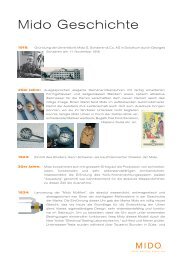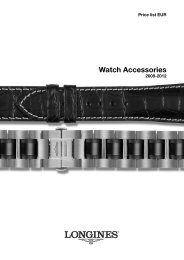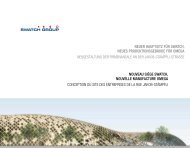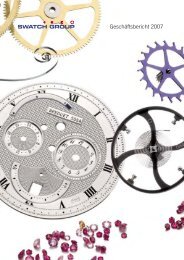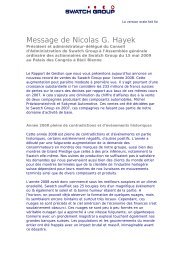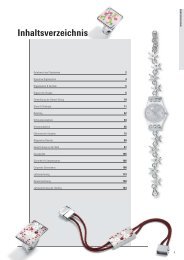PDF Document - Swatch Group
PDF Document - Swatch Group
PDF Document - Swatch Group
You also want an ePaper? Increase the reach of your titles
YUMPU automatically turns print PDFs into web optimized ePapers that Google loves.
Are there any links with traditional Japanese architecture behind these spatial situations?<br />
SB: No, this is not a Japanese building. Of course it stands in Japan, but apart from that there are no<br />
links to Japanese culture. As for myself, I have neither studied architecture in Japan nor do I see<br />
myself as a Japanese architect.<br />
Does the Japanese building tradition not play any role for you?<br />
SB: It perhaps indirectly influences me. For me, however, the Japanese culture is not a theme or a<br />
vocabulary for design work. For example, the Japanese didn't actually invent paper so when I build<br />
houses using paper it’s not building in a Japanese style. The structures with cardboard tubes are my<br />
inventions. They are a new way of using paper.<br />
You come from Japan and have studied in the USA, work frequently in Paris and build in<br />
Europe. Now you are designing the headquarters in Japan for the <strong>Swatch</strong> <strong>Group</strong>, which is a<br />
European company. Isn't all this cultural exchange a kind of theme for you?<br />
SB: That isn't really anything particularly special any more. I have already built for an Italian in New<br />
York and for Japanese clients in Europe. Of course, there are differences, every country is different.<br />
That is exciting to have to keep in mind and at times it's exhausting. For example, in Japan they build<br />
much faster than in Europe. There people work in shifts and if it's got to be done quickly then one<br />
hires more people; in that way you can keep to a schedule. In Europe, I've had to learn to be patient.<br />
Back to the Nicolas G. Hayek Centre: You are going to completely cover one side wall in<br />
plants. Can I assume that here there is also no connection with the Japanese garden?<br />
SB: Not at all. The plants come from over half the countries of the world; these days it's the same<br />
everywhere. The largest part of the wall will be covered with evergreen plants, but one part of it does<br />
follow the seasons of the year: at Christmas, for example, we could plant red poinsettias there.<br />
What is the idea behind the green wall - is it more as decoration?<br />
SB: Yes, it could become a sort of miniature park, because in the surroundings of the Nicolas G.<br />
Hayek Centre in this shopping quarter of Tokyo there is nowhere to relax. I was thinking about the<br />
pocket parks in New York: a small garden in the middle of all the hustle and bustle where one can<br />
relax, look at some greenery and hear water splashing. As we have no space for the garden on the<br />
ground floor, we are just suspending it instead.<br />
Internally the building promises lots of experiences. But when the shops are closed and the<br />
glass shutters are down, the building will appear a bit dull.<br />
SB: Precisely as it should do. I like to create unique spaces – spatial experiences. Many clients and<br />
architects as well want a statement – something unusual. For me, the decoration and the cosmetics are<br />
not of interest.<br />
These spatial experiences need space. This is a piece of luxury in a location where all the<br />
others make use of every last available square metre.<br />
SB: Absolutely. The sales area is four storeys high; it has lots of air and not much space. Subscribing<br />
to this concept is a courageous step by the <strong>Swatch</strong> <strong>Group</strong>, because good architecture should be more<br />
important than pure profit. But Mr Nicolas G. Hayek is someone who is full of ideas and it seemed to<br />
me that this building would be something that appeals to him.








